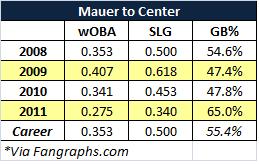
I started
this one-room crap-shack of a blog all the way back in 2006 out of boredom and
in need of a baseball outlet. The original intend was not to entertain or
attract a significant audience or even advance a writing career. I simply
wanted to keep myself busy with my favorite passion.
You see, we
had just had my daughter Avery and had taken a new position in my company that
would send me on the road quite often. Without much to do in far-flung Marriott
Courtyard in some largely suburban community, I saturated myself with as much
baseball knowledge as I possibly could on statistics and how they can be
applied to the game I loved so much.
But enough about what I do in hotel rooms alone.
Frankly, I
enjoyed doing the research – asking myself questions and seeing if I can use
data to determine answers or provide insight towards the game. Somewhere along
the way, other people began to enjoy my research or writing or whatever because
people starting crowding in to read my posts on a regular basis.
I was fortunate
enough to meet some outstanding Twins bloggers in John Bonnes, Nick Nelson and
Seth Stohs (among others) only to discover that we all had the same passion
and/or self-destructive behavior for providing free Twins content on the
Internet. We formed TwinsCentric to pool our collective talents together to
provide content to the Star Tribune (also for free).
But, man,
what a hassle for you, the reader, right? I mean, each morning, stops at my
site, Seth’s site, Nick’s site, that weird site with photos of farm animals
dressed like people, the Star Tribune’s TwinsCentric site and then, if you had
time, John’s site. With all that surfing you figure we must be costing your
companies a ton in lost wages as you spend from 8 AM to 1:28 PM -each day going
from Twins blog -to-Twins blog.
So, while the
Occupy Wall Streeters continue to tear down big corporations, we at
TwinsCentric plan to assist the poor, defenseless coporations – at the very
least, by attempting to get their lost wages back. Starting today, the
TwinsCentric team is launching a new endeavor, TwinsDaily.com,
your source for not only informative and entertaining posts from your four
favorite Twins bloggers but also a place to discuss and
debate with other Twins fans.
With forces
joined, we figured we could at least save the good people of Cyberspaceville
the annoyance of making multiple stops along the information superhighway. Now
you can lap up all the Twins news, content and chatter you want in one spot -- just
like an Old Country Buffett with an open bar.
So, oddly
enough, I am going to miss this shack. It’s the one I took care of for six long
years and honestly, not very well. After all, I never actually gave it a real
URL. Still, I will not be more than a click away as I will be posting at my new
location within the Twins Daily site (found
here). Additionally, all my archived posts will remain up here at the old
site just in case you want to scroll through the posts and tell me how wrong I
was back in 2010 when I called Glen Perkins washed up (plenty of crow eaten on
that one).
Thanks again
for stopping by this old girl. See you at the new home.
****
Twins Daily: www.TwinsDaily.com
Twins Daily
on Facebook: http://www.facebook.com/pages/Twins-Daily/278788618854034?sk=wall
Twins Daily on Twitter: https://twitter.com/#!/TwinsDaily
My Blog: www.TwinsDaily.com/blog.php?8







.jpg)
.jpg)



